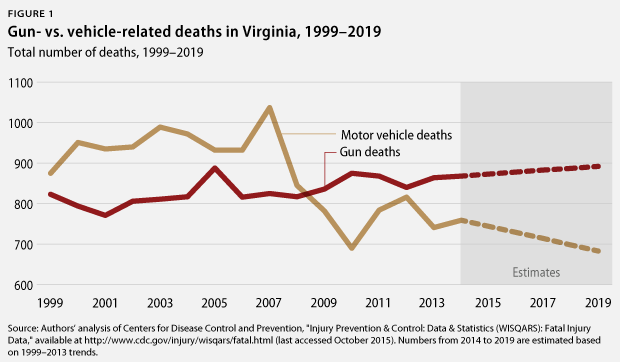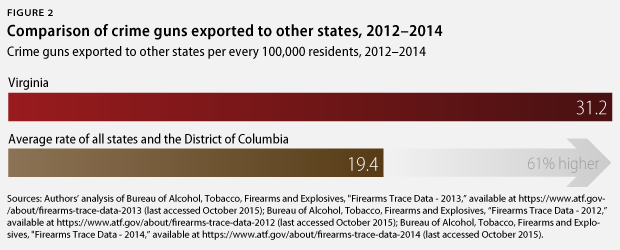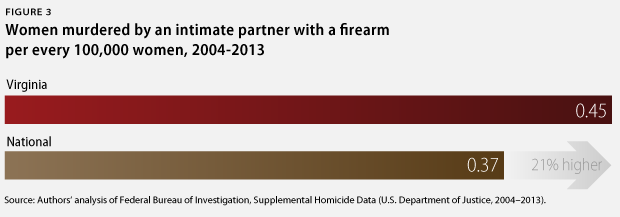In some respects, gun violence in Virginia is typical of that in much of the nation. For example, Virginia ranked 28th of the 50 states for the overall rate of gun deaths from 2004 to 2013—right in the middle of the states. On the other hand, Virginia has been the scene of some of the most horrific, high-profile acts of gun violence in recent memory: the massacre at Virginia Tech in 2007 and the on-air execution of reporter Alison Parker and cameraman Adam Ward in August 2015. In fact, in the eight and a half years since the mass shooting at Virginia Tech, approximately 7,173 Virginians have died by gunfire. These appalling incidents; Virginia’s proximity to the nation’s capital; and the fact that the National Rifle Association, or NRA, is headquartered in Virginia have made the commonwealth a national bellwether for the debate over gun laws.
In recent years, the gun issue has been vigorously contested in political races across the state. For example, during the 2013 statewide elections, the NRA and two gun violence prevention groups—Americans for Responsible Solutions, a group founded by former Rep. Gabrielle Giffords (D-AZ), and Independence USA, a political action committee created by former New York City Mayor Michael Bloomberg (I)—collectively spent close to $4 million attempting to influence the outcome. That year, all three of the winning candidates for statewide office—Gov. Terry McAuliffe (D), Lt. Gov. Ralph Northam (D), and Attorney General Mark Herring (D)—took strong positions in favor of strengthening gun laws, opposed the NRA, and explicitly campaigned on their support for common-sense gun laws.
Despite the success that gun violence prevention groups enjoyed in the 2013 elections, efforts to strengthen gun laws in the state legislature have remained stalled. The Virginia legislature even failed to act on legislation to keep guns out of the hands of domestic abusers—a law that passed with broad bipartisan support in a number of other states—despite its successful passage in the state Senate in 2014 after a 29-6 vote. With elections for all seats in the state General Assembly and Senate scheduled for November 3, 2015, the issue of gun violence is once again on the minds of many Virginia voters. Gov. McAuliffe has continued to focus on this issue, recently announcing six new executive actions to address gun violence in the state, including creating a joint task force to prosecute gun crimes, implementing a crime gun tipline, and providing training for judges and prosecutors to encourage domestic abusers to surrender firearms. Gov. McAuliffe has also pledged to continue pushing the state legislature to enact common-sense gun laws in the upcoming legislative session.
This issue brief provides additional context about what is at stake as Virginia voters consider which leaders they want to represent them in Richmond. It discusses four aspects of gun violence and gun-related crime in Virginia that are exceptional, unique, or above the national average:
- More Virginians are killed annually by gunfire than in car accidents.
- Virginia is one of the top exporters of crime guns.
- Women are killed with guns by intimate partners at a high rate in Virginia.
- Virginia has been disproportionately affected by mass shootings.
The 2007 Virginia Tech massacre remains the deadliest mass shooting in American history. In its wake, then-Gov. Tim Kaine (D) acted to ensure that more mental health records were accessible to the gun background check system—after the gap led directly to the Virginia Tech shooting. Since then, the rate at which Virginia submits mental health records has grown substantially, and the state now ranks third in the nation: To date, 224,079 records have been submitted to the background check system. Yet efforts to continue building on that progress and strengthen Virginia’s laws and policies to address gun violence have been largely stymied by the state legislature. With 86 percent of Virginians supportive of legislation that would require background checks for all gun sales, the issue of gun violence prevention is certainly on many voters’ minds as they head to the polls.
1. More Virginians are killed annually by gunfire than in car accidents
For decades, more Americans have been killed annually in motor vehicle accidents than by gunfire. In response to the tens of thousands of car accident deaths every year, elected officials, policymakers, and the car industry have taken a number of steps to improve motor vehicle safety, including gathering and analyzing car death data, enhancing car design, implementing better technology, and improving road safety. As a result of this comprehensive approach to this public safety issue, the number of deaths from car accidents across the country has significantly declined. While there were 40,965 car accident deaths nationwide in 1999, that number dropped to 33,804 by 2013, a 17 percent decrease. Virginia has followed a similar trend: From 1999 to 2013, car accident deaths in the state declined 15 percent.
By contrast, few national resources have been devoted to understanding gun violence and developing a comprehensive, evidence-based approach to reducing gun deaths. The NRA has effectively blocked public health research into gun deaths through limiting amendments to annual appropriations bills for the Centers for Disease Control and Prevention, or CDC, and the National Institutes of Health, or NIH, and many legislative bodies have lacked the political will to strengthen gun laws. During the same period that U.S. deaths due to car accidents were declining, deaths by gunfire were rising: While there were 28,874 gun deaths nationwide in 1999, that number increased to 33,636 by 2013, a 16 percent increase.
As a result of the disparate approaches to these two serious public health issues, the gap between gun-related and vehicle-related deaths has shrunk significantly in recent years. While the number of U.S. motor vehicle accident deaths was 42 percent higher than gun-related deaths in 1999, this difference had decreased to less than 0.5 percent by 2013. A number of studies have concluded that these lines will cross sometime this year, when gun deaths outpace deaths due to car accidents. A 2014 report by Generation Progress and the Center for American Progress projected that 2015 will also be the year that guns become the leading cause of death of young people in the United States.
Virginia is one of 17 states, along with the District of Columbia, where these lines have already crossed. In 2009, guns accounted for the deaths of more Virginians than car accidents for the first time. In 2013, the most recent year for which data are available, gun deaths were 17 percent higher than car accident deaths. If current trends continue, the number of gun deaths in Virginia will be 24 percent higher than the number of car accident deaths by the end of the next assembly’s term in 2017 and 31 percent higher by the end of the next Senate’s term in 2019.

2. Virginia is one of the top exporters of crime guns
When a gun is recovered at a crime scene, one of the first challenges for investigators is determining from where the gun came. Restrictions on record keeping for gun purchases that are codified in federal law limit this inquiry to determining where the gun was first sold at retail and the identity of the first retail purchaser. To answer these questions, local law enforcement turns to the Bureau of Alcohol, Tobacco, Firearms and Explosives, or ATF, which can trace guns from manufacturer through the first point of sale. Part of the tracing process involves identifying whether a gun crossed state lines before being used in a crime. A significant number of crime guns do move from state to state: From 2012 to 2014, 29 percent of guns recovered in crimes and traced were first purchased at retail in another state.
Virginia is one of the top source states for guns recovered in crimes in other states. Due in part to the state’s weak gun laws and the rise of Interstate 95 as a popular corridor for gun traffickers, Virginia exports a substantial number of crime guns. From 2012 to 2014, Virginia had the nation’s ninth highest rate of crime guns exported to other states, with a rate 61 percent higher than the national average. Moreover, with more than 7,700 firearms purchased in Virginia and later recovered at crime scenes in other states, the state ranked third in terms of the absolute number of crime gun exports. Only Georgia and Texas exported a higher number of crime guns—9,134 and 8,103, respectively.

The movement of guns across state lines from states with weaker gun laws, such as Virginia, undermines other states’ efforts to enact strong gun laws and curb gun violence. From 2012 to 2014, 60 percent of crime guns traced back to Virginia were either recovered in the District of Columbia or in one of the 10 states with the strongest gun laws, according to a ranking of state gun laws provided by the Law Center to Prevent Gun Violence. An analysis of crime guns recovered in New York City in 2011 revealed that 90 percent came from out of state, with more crime guns coming from Virginia than from any other state.
3. Women are killed with guns by intimate partners at a high rate in Virginia
American women face unique challenges when it comes to gun violence. Studies show that while they are killed less frequently than men, they are much more likely to be murdered by someone they know. In the majority of these cases, the aggressor is an intimate partner. According to information from the FBI, 34 percent of women murdered in the United States from 2004 to 2013 were killed by an intimate partner; 55 percent of those murders were committed with a firearm.
The risk of intimate partner gun homicides against women is even higher in Virginia. From 2004 to 2013, 37 percent of female murder victims in Virginia were killed by an intimate partner, and approximately 60 percent of those murders were carried out with a firearm. The state’s rate of intimate partner gun homicides of women during this period was 21 percent higher than the national average. Additionally, Virginia ranks 16th worst in the nation for the rate of intimate partner gun murders of women. Many perpetrators of intimate partner homicide in Virginia have a history of domestic violence. A recent study by the Educational Fund to Stop Gun Violence found that more than one-third of perpetrators of intimate partner homicides in the state in 2014 had a history of violence or threats against the victim and that of those perpetrators, 74 percent used a gun to commit the murder.

4. Virginia has been disproportionately affected by mass shootings
The FBI defines mass shootings as incidents in which four or more victims are killed with a firearm. While they constitute a small portion of overall gun violence in the United States, mass shootings receive the bulk of the media’s attention and tend to have a profound impact on the population. Moreover, research from the Harvard School of Public Health shows that the rate of mass shootings in the United States has tripled since 2011.
Virginia ranks ninth among all of the states for the highest rate of victims killed in mass shootings. This is driven in large part by the Virginia Tech massacre, in which 32 people were murdered—the worst mass shooting in American history to date. Virginia has also experienced a number of family-related mass shootings that contribute to this ranking. These include a 2014 incident in Culpeper, Virginia, in which a man fatally shot his wife and three daughters before taking his own life. In a 2011 case, a man involved in a custody dispute fatally shot his two children, their mother, and another man before killing himself. When considering the raw number of victims of fatal mass shootings, Virginia ranks fourth highest overall, with 56 people killed in these incidents from 2006 to October 2015. Overall, 1 in every 20 victims of fatal mass shootings in the United States from 2006 to 2015 were killed in Virginia.
Conclusion
Over the next four years, an estimated 3,540 people will be killed with guns in Virginia if current trends continue.
Gun violence is an urgent public health issue that demands attention and action from the state’s leadership. There is much more that can be done to both strengthen Virginia’s laws to prevent gun deaths and reduce the illegal flow of guns across state lines into other communities being ravaged by gun violence. Upon beginning their term in January 2016, the newly elected members of the next Virginia legislature should take up legislation that would address key weaknesses in the state’s gun laws, including requiring universal background checks, prohibiting domestic abusers and stalkers from buying and possessing guns, and ensuring surrender of guns by all prohibited individuals.
Chelsea Parsons is the Vice President of Guns and Crime Policy at the Center for American Progress. Tim Daly is the Director for Campaigns and Eugenio Weigend is the Senior Policy Analyst for the Center’s Guns and Crime Policy team.